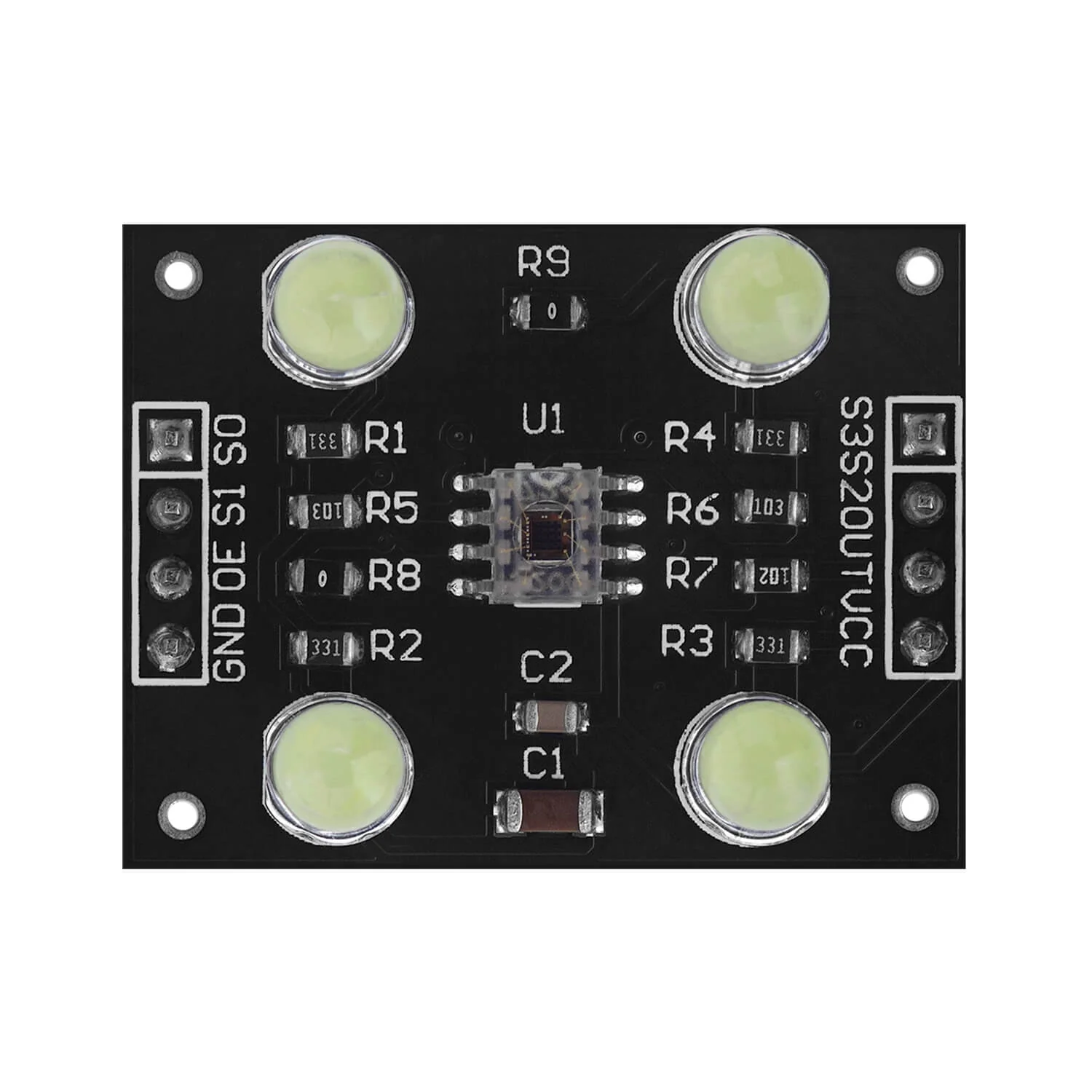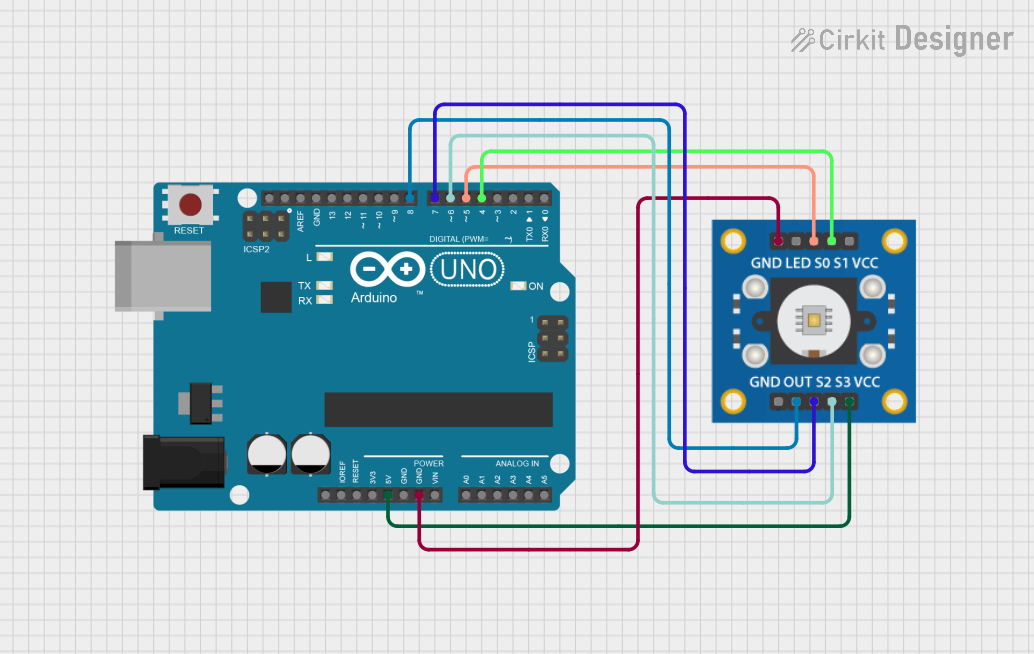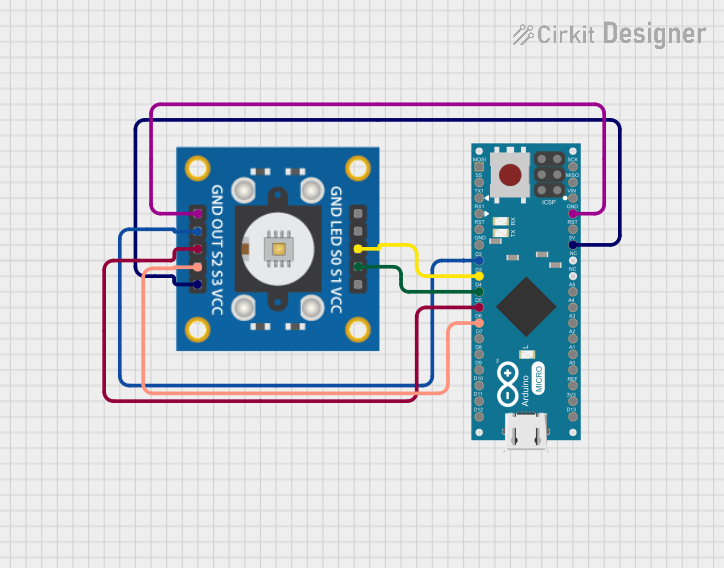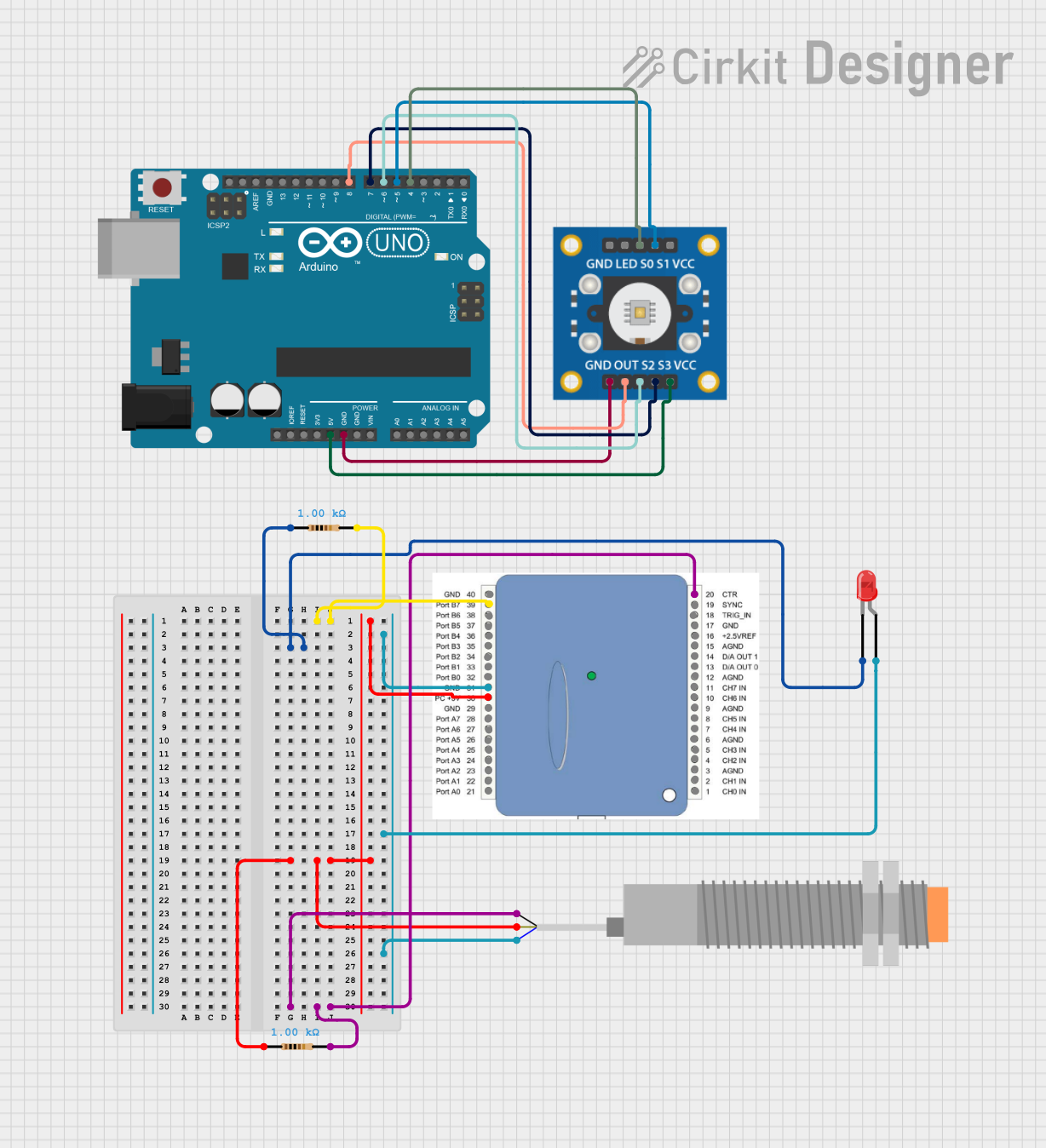
How to Use TCS230 color sensor: Examples, Pinouts, and Specs

 Design with TCS230 color sensor in Cirkit Designer
Design with TCS230 color sensor in Cirkit DesignerIntroduction
The TCS230 color sensor is a device that detects and measures the color of objects. It uses an array of photodiodes with red, green, blue, and clear filters to capture color data, which can be processed to determine the color of the surface being observed. The sensor outputs a square wave whose frequency is proportional to the intensity of the detected color.
This sensor is widely used in applications such as:
- Robotics for color recognition and sorting tasks
- Industrial automation for quality control
- Consumer electronics for color detection
- Educational projects involving Arduino and other microcontrollers
Explore Projects Built with TCS230 color sensor

 Open Project in Cirkit Designer
Open Project in Cirkit Designer
 Open Project in Cirkit Designer
Open Project in Cirkit Designer
 Open Project in Cirkit Designer
Open Project in Cirkit Designer
 Open Project in Cirkit Designer
Open Project in Cirkit DesignerExplore Projects Built with TCS230 color sensor

 Open Project in Cirkit Designer
Open Project in Cirkit Designer
 Open Project in Cirkit Designer
Open Project in Cirkit Designer
 Open Project in Cirkit Designer
Open Project in Cirkit Designer
 Open Project in Cirkit Designer
Open Project in Cirkit DesignerTechnical Specifications
The TCS230 color sensor is a programmable color light-to-frequency converter. Below are its key technical details:
Key Specifications
| Parameter | Value |
|---|---|
| Supply Voltage | 2.7V to 5.5V |
| Operating Current | 2mA (typical) |
| Output | Square wave (frequency output) |
| Frequency Scaling Options | 100%, 20%, 2% |
| Photodiode Filters | Red, Green, Blue, and Clear |
| Operating Temperature | -40°C to 85°C |
Pin Configuration and Descriptions
The TCS230 sensor module typically comes with an 8-pin interface. Below is the pinout:
| Pin Name | Pin Number | Description |
|---|---|---|
| VCC | 1 | Power supply input (2.7V to 5.5V) |
| GND | 2 | Ground connection |
| S0 | 3 | Output frequency scaling selection (with S1) |
| S1 | 4 | Output frequency scaling selection (with S0) |
| S2 | 5 | Photodiode filter selection (with S3) |
| S3 | 6 | Photodiode filter selection (with S2) |
| OUT | 7 | Output pin providing square wave frequency proportional to light intensity |
| OE | 8 | Output enable (active low, can be tied to GND for continuous operation) |
Frequency Scaling Table
| S0 | S1 | Output Frequency Scaling |
|---|---|---|
| 0 | 0 | Power down mode |
| 0 | 1 | 2% |
| 1 | 0 | 20% |
| 1 | 1 | 100% |
Photodiode Filter Selection Table
| S2 | S3 | Photodiode Filter Selected |
|---|---|---|
| 0 | 0 | Red |
| 0 | 1 | Blue |
| 1 | 0 | Clear (no filter) |
| 1 | 1 | Green |
Usage Instructions
How to Use the TCS230 in a Circuit
- Power the Sensor: Connect the VCC pin to a 5V power supply and the GND pin to ground.
- Set Frequency Scaling: Use the S0 and S1 pins to set the desired output frequency scaling.
- Select Color Filter: Use the S2 and S3 pins to select the desired photodiode filter (Red, Green, Blue, or Clear).
- Read Output: Connect the OUT pin to a microcontroller or frequency counter to measure the output frequency, which corresponds to the intensity of the selected color.
- Enable Output: Ensure the OE pin is connected to GND or controlled by the microcontroller to enable the output.
Important Considerations and Best Practices
- Ambient Light: Minimize ambient light interference by enclosing the sensor or using it in controlled lighting conditions.
- Calibration: Calibrate the sensor for accurate color detection by measuring known color samples and adjusting your code accordingly.
- Frequency Scaling: Use lower frequency scaling (e.g., 2%) for high-intensity light sources to avoid saturation.
- Output Filtering: Use software or hardware filtering to smooth the output frequency for more stable readings.
Example Code for Arduino UNO
Below is an example of how to interface the TCS230 color sensor with an Arduino UNO to detect color:
// Pin definitions for TCS230
#define S0 4 // Connect to S0 pin of TCS230
#define S1 5 // Connect to S1 pin of TCS230
#define S2 6 // Connect to S2 pin of TCS230
#define S3 7 // Connect to S3 pin of TCS230
#define OUT 8 // Connect to OUT pin of TCS230
void setup() {
// Set pin modes
pinMode(S0, OUTPUT);
pinMode(S1, OUTPUT);
pinMode(S2, OUTPUT);
pinMode(S3, OUTPUT);
pinMode(OUT, INPUT);
// Set frequency scaling to 20%
digitalWrite(S0, HIGH);
digitalWrite(S1, LOW);
Serial.begin(9600); // Initialize serial communication
}
void loop() {
// Select Red filter
digitalWrite(S2, LOW);
digitalWrite(S3, LOW);
int redFrequency = pulseIn(OUT, LOW); // Measure frequency for red
// Select Green filter
digitalWrite(S2, HIGH);
digitalWrite(S3, HIGH);
int greenFrequency = pulseIn(OUT, LOW); // Measure frequency for green
// Select Blue filter
digitalWrite(S2, LOW);
digitalWrite(S3, HIGH);
int blueFrequency = pulseIn(OUT, LOW); // Measure frequency for blue
// Print the frequency values
Serial.print("Red: ");
Serial.print(redFrequency);
Serial.print(" Green: ");
Serial.print(greenFrequency);
Serial.print(" Blue: ");
Serial.println(blueFrequency);
delay(500); // Wait for 500ms before the next reading
}
Troubleshooting and FAQs
Common Issues and Solutions
No Output Signal:
- Ensure the OE pin is connected to GND or controlled properly.
- Verify the power supply voltage is within the specified range (2.7V to 5.5V).
Inconsistent Readings:
- Check for ambient light interference and reduce it if necessary.
- Ensure proper calibration of the sensor for the specific application.
Saturation of Output:
- Use a lower frequency scaling (e.g., 2%) for high-intensity light sources.
Incorrect Color Detection:
- Verify the S2 and S3 pin configurations for the correct filter selection.
- Calibrate the sensor using known color samples.
FAQs
Q: Can the TCS230 detect black and white?
A: Yes, the TCS230 can detect black and white by measuring the intensity of light reflected from the surface using the Clear (no filter) mode.
Q: How do I improve the accuracy of color detection?
A: Use proper calibration, minimize ambient light interference, and ensure the sensor is positioned at a consistent distance from the object.
Q: Can the TCS230 be used with a 3.3V microcontroller?
A: Yes, the TCS230 operates within a voltage range of 2.7V to 5.5V, making it compatible with 3.3V systems.